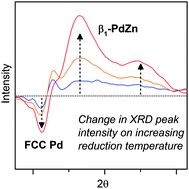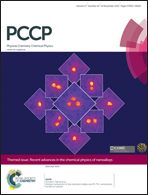Structural evolution of an intermetallic Pd–Zn catalyst selective for propane dehydrogenation†
Abstract
We report the structural evolution of Pd–Zn alloys in a 3.6% Pd–12% Zn/Al2O3 catalyst which is selective for propane dehydrogenation. High signal-to-noise, in situ synchrotron X-ray diffraction (XRD) was used quantitatively, in addition to in situ diffuse-reflectance infrared Fourier transform spectroscopy (DRIFTS) and extended X-ray absorption fine structure (EXAFS) to follow the structural changes in the catalyst as a function of reduction temperature. XRD in conjunction with DRIFTS of adsorbed CO indicated that the β1-PdZn intermetallic alloy structure formed at reduction temperatures as low as 230 °C, likely first at the surface, but did not form extensively throughout the bulk until 500 °C which was supported by in situ EXAFS. DRIFTS results suggested there was little change in the surfaces of the nanoparticles above 325 °C. The intermetallic alloy which formed was Pd-rich at all temperatures but became less Pd-rich with increasing reduction temperature as more Zn incorporated into the structure. In addition to the β1-PdZn alloy, a solid solution phase with face-center cubic structure (α-PdZn) was present in the catalyst, also becoming more Zn-rich with increasing reduction temperature.

- This article is part of the themed collection: Recent advances in the chemical physics of nanoalloys

 Please wait while we load your content...
Please wait while we load your content...